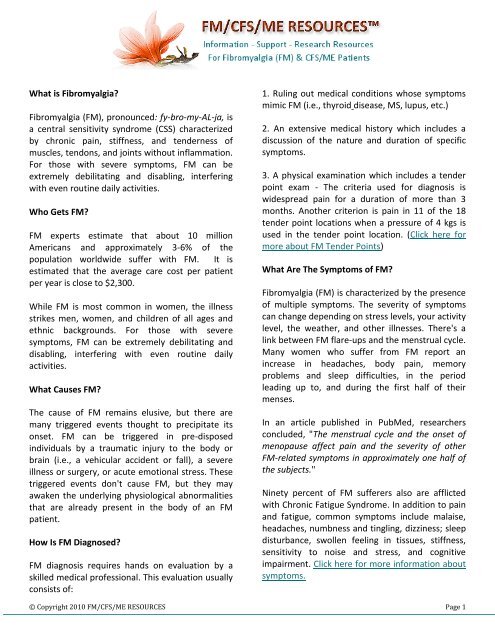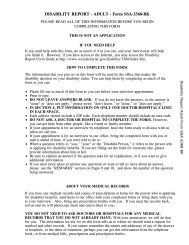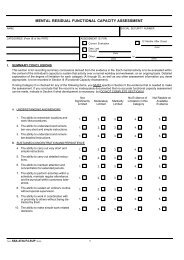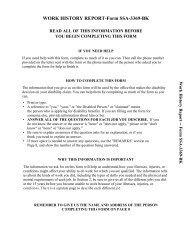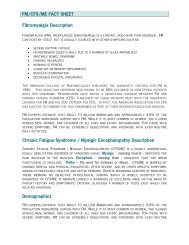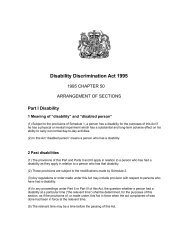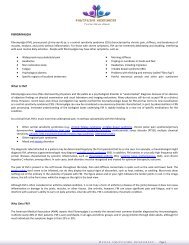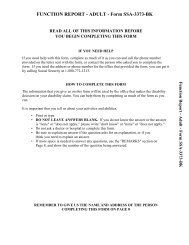Fibromyalgia (FM) - FM/CFS/ME Resources
Fibromyalgia (FM) - FM/CFS/ME Resources
Fibromyalgia (FM) - FM/CFS/ME Resources
Create successful ePaper yourself
Turn your PDF publications into a flip-book with our unique Google optimized e-Paper software.
What is <strong>Fibromyalgia</strong>?<br />
<strong>Fibromyalgia</strong> (<strong>FM</strong>), pronounced: fy-bro-my-AL-ja, is<br />
a central sensitivity syndrome (CSS) characterized<br />
by chronic pain, stiffness, and tenderness of<br />
muscles, tendons, and joints without inflammation.<br />
For those with severe symptoms, <strong>FM</strong> can be<br />
extremely debilitating and disabling, interfering<br />
with even routine daily activities.<br />
Who Gets <strong>FM</strong>?<br />
<strong>FM</strong> experts estimate that about 10 million<br />
Americans and approximately 3-6% of the<br />
population worldwide suffer with <strong>FM</strong>. It is<br />
estimated that the average care cost per patient<br />
per year is close to $2,300.<br />
While <strong>FM</strong> is most common in women, the illness<br />
strikes men, women, and children of all ages and<br />
ethnic backgrounds. For those with severe<br />
symptoms, <strong>FM</strong> can be extremely debilitating and<br />
disabling, interfering with even routine daily<br />
activities.<br />
What Causes <strong>FM</strong>?<br />
The cause of <strong>FM</strong> remains elusive, but there are<br />
many triggered events thought to precipitate its<br />
onset. <strong>FM</strong> can be triggered in pre-disposed<br />
individuals by a traumatic injury to the body or<br />
brain (i.e., a vehicular accident or fall), a severe<br />
illness or surgery, or acute emotional stress. These<br />
triggered events don't cause <strong>FM</strong>, but they may<br />
awaken the underlying physiological abnormalities<br />
that are already present in the body of an <strong>FM</strong><br />
patient.<br />
How Is <strong>FM</strong> Diagnosed?<br />
<strong>FM</strong> diagnosis requires hands on evaluation by a<br />
skilled medical professional. This evaluation usually<br />
consists of:<br />
1. Ruling out medical conditions whose symptoms<br />
mimic <strong>FM</strong> (i.e., thyroid disease, MS, lupus, etc.)<br />
2. An extensive medical history which includes a<br />
discussion of the nature and duration of specific<br />
symptoms.<br />
3. A physical examination which includes a tender<br />
point exam - The criteria used for diagnosis is<br />
widespread pain for a duration of more than 3<br />
months. Another criterion is pain in 11 of the 18<br />
tender point locations when a pressure of 4 kgs is<br />
used in the tender point location. (Click here for<br />
more about <strong>FM</strong> Tender Points)<br />
What Are The Symptoms of <strong>FM</strong>?<br />
<strong>Fibromyalgia</strong> (<strong>FM</strong>) is characterized by the presence<br />
of multiple symptoms. The severity of symptoms<br />
can change depending on stress levels, your activity<br />
level, the weather, and other illnesses. There's a<br />
link between <strong>FM</strong> flare-ups and the menstrual cycle.<br />
Many women who suffer from <strong>FM</strong> report an<br />
increase in headaches, body pain, memory<br />
problems and sleep difficulties, in the period<br />
leading up to, and during the first half of their<br />
menses.<br />
In an article published in PubMed, researchers<br />
concluded, "The menstrual cycle and the onset of<br />
menopause affect pain and the severity of other<br />
<strong>FM</strong>-related symptoms in approximately one half of<br />
the subjects."<br />
Ninety percent of <strong>FM</strong> sufferers also are afflicted<br />
with Chronic Fatigue Syndrome. In addition to pain<br />
and fatigue, common symptoms include malaise,<br />
headaches, numbness and tingling, dizziness; sleep<br />
disturbance, swollen feeling in tissues, stiffness,<br />
sensitivity to noise and stress, and cognitive<br />
impairment. Click here for more information about<br />
symptoms.<br />
© Copyright 2010 <strong>FM</strong>/<strong>CFS</strong>/<strong>ME</strong> RESOURCES Page 1
How is <strong>FM</strong> Treated?<br />
Since there is no cure for <strong>Fibromyalgia</strong> (<strong>FM</strong>),<br />
treatments are geared towards improving the<br />
quality of sleep and reducing pain. Treatments take<br />
on several different forms. There are medications,<br />
trigger-point injections, physical therapy,<br />
occupational therapy, acupuncture, acupressure,<br />
relaxation techniques, biofeedback techniques and<br />
osteopathic manipulative medicine.<br />
Deep level sleep (stage 4 sleep) is crucial for many<br />
body functions such as tissue repair, antibody<br />
production, and the regulation of various<br />
neurotransmitters, hormones and immune system<br />
chemicals.<br />
Therefore, sleep disorders that occur in <strong>FM</strong> are<br />
treated first because they may be a strong<br />
contributing factor to the symptoms of <strong>FM</strong>. There<br />
are many different types of treatments for sleep<br />
disorders to be considered. Click here for more<br />
information about treatments.<br />
What Are Tender Points?<br />
Tender points are areas that cause pain but do not<br />
display the typical signs of discomfort, such as heat,<br />
redness, or swelling. There are eighteen tender<br />
points that consist of<br />
nine bilateral sites<br />
adding up to eighteen<br />
in total. The red dots<br />
in the picture to your<br />
left indicate the 18<br />
tender point sites that<br />
have been identified<br />
by the American<br />
College<br />
of<br />
Rheumatology (ACR).<br />
months and feels pain in 11 or more of the 18<br />
pressure point sites.<br />
Doctors measure these tender points in one of two<br />
ways: by pressing the site with a finger or by using<br />
a slightly higher-tech method called dolorimetry<br />
In the dolorimetry method, the examiner presses a<br />
rubber endplate, attached to a spring-loaded force<br />
gauge, into the tender point site with increasing<br />
force. Patients are then asked to say when they<br />
stop feeling pressure and start feeling pain. Click<br />
here for more information about <strong>FM</strong> tender points.<br />
Can <strong>FM</strong> Be Cured?<br />
Although there is currently no cure for <strong>FM</strong>,<br />
symptoms can be substantially controlled by<br />
comprehensive treatment that includes education,<br />
medication, and physical conditioning to improve<br />
aerobic capacity and flexibility, and psychological<br />
intervention aimed at stress management.<br />
How Long Can <strong>FM</strong> Last?<br />
People with <strong>FM</strong> may reach a remissive period after<br />
a few months, or after many years, or never at all.<br />
Often, the symptoms change over time, or cycle<br />
irregularly. Relapses are common, especially after<br />
stressful life events or additional illness. Exertion<br />
can cause not merely a relapse, but a worsening of<br />
overall health. Undiagnosed cases of <strong>FM</strong> often<br />
worsen as the sufferer attempts to return to a<br />
"normal" level of activity, only to make their<br />
condition worse through exertion. Of those <strong>FM</strong><br />
patients moderately to severely affected, many<br />
may expect to remain so for an indeterminate<br />
period, even for the duration of their life.<br />
According to the ACR criteria, <strong>FM</strong> is present when a<br />
patient suffers widespread pain for at least three<br />
© Copyright 2010 <strong>FM</strong>/<strong>CFS</strong>/<strong>ME</strong> RESOURCES Page 2
What is Chronic Fatigue Syndrome/Myalgic<br />
Encephalopathy? (<strong>CFS</strong>/<strong>ME</strong>)<br />
Chronic Fatigue Syndrome/Myalgic Encephalopathy<br />
(<strong>CFS</strong>/<strong>ME</strong>) is a serious, disabling and chronic neuroimmune<br />
illness affecting approximately 1 million<br />
people in the United States and as many as 17<br />
million people worldwide.<br />
<strong>CFS</strong>/<strong>ME</strong> is characterized by debilitating fatigue<br />
(exhaustion and extremely poor stamina),<br />
neurological problems and a variety of flu-like<br />
symptoms.<br />
Myalgic - meaning muscle - indicates the pain<br />
involved in the muscles. Encephalo - meaning<br />
brain - indicates that the brain functioning is<br />
involved. Pathy – the word for sickness or illness.<br />
The illness is also known as chronic fatigue immune<br />
dysfunction syndrome (CFIDS). In the past the<br />
syndrome has been known as chronic Epstein-Barr<br />
virus (CEBV).<br />
Who Gets <strong>CFS</strong>/<strong>ME</strong>?<br />
<strong>CFS</strong>/<strong>ME</strong> occurs four times more frequently in<br />
women than in men, although people of either<br />
gender can develop the disease. The illness occurs<br />
most often in people in their 40s and 50s, but<br />
people of all ages can get <strong>CFS</strong>/<strong>ME</strong>. Children and<br />
adolescents are not immune to its effects. Most<br />
studies indicate that girls are more apt to develop<br />
<strong>CFS</strong>/<strong>ME</strong> than boys, although one study found the<br />
incidence of the syndrome to be equal. According<br />
to a 1999 study, half of the children and<br />
adolescents with <strong>CFS</strong>/<strong>ME</strong> also suffer psychiatric<br />
disorders, primarily anxiety, and also depression.<br />
<strong>CFS</strong>/<strong>ME</strong> occurs in all ethnic and racial groups, and<br />
in countries around the world. Research indicates<br />
that <strong>CFS</strong>/<strong>ME</strong> is at least as common among African<br />
Americans and Hispanics as it is among Caucasians.<br />
People of all income levels can develop <strong>CFS</strong>/<strong>ME</strong>.<br />
<strong>CFS</strong>/<strong>ME</strong> is sometimes seen in members of the same<br />
family, but there's no evidence that it's contagious.<br />
Instead, there may be a familial or genetic link.<br />
Further research is needed to explore this.<br />
What Causes <strong>CFS</strong>/<strong>ME</strong>?<br />
The cause of the illness is not yet known. Current<br />
theories are looking at the possibilities of<br />
neuroendocrine dysfunction, viruses,<br />
environmental toxins, genetic predisposition, or a<br />
combination of these. For a time it was thought<br />
that Epstein - Barr virus (EBV), the cause of<br />
mononucleosis, might cause <strong>CFS</strong>/<strong>ME</strong> but recent<br />
research has discounted this idea. The illness<br />
seems to prompt a chronic immune reaction in the<br />
body, however it is not clear that this is in response<br />
to any actual infection - this may only be a<br />
dysfunction of the immune system itself.<br />
Scientists have discovered a potential retroviral link<br />
to <strong>CFS</strong>/<strong>ME</strong>. Researchers from the Whittemore<br />
Peterson Institute, the National Cancer Institute,<br />
and the Cleveland Clinic, report this finding online<br />
in the Oct. 8, 2009, issue of Science.<br />
"We now have evidence that a retrovirus named<br />
XMRV is frequently present in the blood of patients<br />
with <strong>CFS</strong>. This discovery could be a major step in<br />
the discovery of vital treatment options for millions<br />
of patients," said Judy Mikovits, PhD, director of<br />
research for WPI and leader of the team that<br />
discovered this association.<br />
Researchers cautioned, however, that this finding<br />
show there is an association between XMRV and<br />
<strong>CFS</strong> but does not prove that XMRV causes <strong>CFS</strong>.<br />
There is still a long way to go, but at least now it<br />
can be proven that <strong>CFS</strong>/<strong>ME</strong> is indeed a real illness.<br />
© Copyright 2010 <strong>FM</strong>/<strong>CFS</strong>/<strong>ME</strong> RESOURCES Page 3
What Causes <strong>CFS</strong>/<strong>ME</strong>? (Continued)<br />
Many medical observers have noted that <strong>CFS</strong>/<strong>ME</strong><br />
seems often to be "triggered" by some stressful<br />
event, but in all likelihood the condition was latent<br />
beforehand. Some people will appear to get<br />
<strong>CFS</strong>/<strong>ME</strong> following a viral infection, or a head injury,<br />
or surgery, excessive use of antibiotics, or some<br />
other traumatic event. Yet it's unlikely that these<br />
events solely could be a primary cause.<br />
How Is <strong>CFS</strong>/<strong>ME</strong> Diagnosed?<br />
Doctors find it difficult to diagnose <strong>CFS</strong>/<strong>ME</strong><br />
because it has the same symptoms as many other<br />
diseases. When talking with and examining you,<br />
your doctor must first rule out diseases that look<br />
similar, such as multiple sclerosis and systemic<br />
lupus erythematosus in which symptoms can take<br />
years to develop. In follow-up visits, you and your<br />
doctor need to be alert to any new cues or<br />
symptoms that might show that the problem is<br />
something other than <strong>CFS</strong>/<strong>ME</strong>. <strong>CFS</strong>/<strong>ME</strong> is<br />
diagnosed as a process of ruling out everything<br />
else!<br />
The criteria for diagnosing <strong>CFS</strong> were officially<br />
defined by the CDC in 1988 and revised in 2001.<br />
The Oxford criteria differ slightly. The British<br />
criteria insist upon the presence of mental fatigue,<br />
although the American criteria include a<br />
requirement for several physical symptoms,<br />
reflecting the belief that <strong>CFS</strong> has an underlying<br />
immune or infectious pathology.<br />
Centers for Disease Control's Criteria for <strong>CFS</strong><br />
clinically evaluated, unexplained, persistent, or<br />
relapsing fatigue that is:<br />
<br />
<br />
<br />
Of new or definite onset<br />
Not a result of ongoing exertion<br />
Not alleviated by rest<br />
Results in a substantial reduction in<br />
previous levels of occupational, social, or<br />
personal activity<br />
Four or more of the following symptoms that<br />
persist or recur during six or more consecutive<br />
months of illness and that do not predate the<br />
fatigue.<br />
<br />
<br />
<br />
<br />
<br />
<br />
<br />
<br />
Self-reported impairment of short-term<br />
memory or concentration<br />
Sore throat<br />
Tender lymph nodes<br />
Muscle pain<br />
Multi joint pain without swelling or redness<br />
Headaches of a new type, pattern, or<br />
severity<br />
Unrefreshed and/or interrupted sleep<br />
Post exertion malaise (a feeling of general<br />
discomfort or uneasiness) lasting more than<br />
24 hours<br />
Exclusion Criteria:<br />
<br />
<br />
<br />
<br />
<br />
<br />
<br />
Active, unresolved or suspected disease<br />
that is likely to cause fatigue<br />
Psychotic, melancholic, bipolar depression<br />
Psychotic disorders<br />
Dementia<br />
Anorexia or bulimia nervosa<br />
Alcohol or other substance misuse<br />
Severe obesity<br />
Oxford (British) Criteria for Chronic Fatigue<br />
Syndrome Severe disabling fatigue of at least six<br />
month duration that:<br />
<br />
<br />
<br />
Affects physical and mental functioning.<br />
Is present for more than 50% of the time.<br />
Other symptoms, particularly myalgia, sleep<br />
and mood disturbances may be present.<br />
© Copyright 2010 <strong>FM</strong>/<strong>CFS</strong>/<strong>ME</strong> RESOURCES Page 4
What Are The Symptoms of <strong>CFS</strong>/<strong>ME</strong>?<br />
According to the 1994 International Case Definition<br />
the symptoms include:<br />
<br />
<br />
<br />
<br />
<br />
<br />
<br />
<br />
<br />
<br />
fatigue lasting for six months or longer that<br />
significantly affects lifestyle<br />
in addition, four or more of the following<br />
symptoms must be present [along with the<br />
debilitating fatigue]<br />
Postexertional malaise (lasting more than<br />
24 hours)<br />
Sleep difficulties / unrefreshed sleep<br />
Impaired memory or concentration<br />
Muscle pain<br />
Multi-joint pain<br />
Headaches of new type, pattern, or severity<br />
Sore throat<br />
Tender lymph nodes in the armpit and neck<br />
Degree of <strong>CFS</strong>/<strong>ME</strong> Severity<br />
The degree of severity can differ widely among<br />
patients, and will also vary over time for the same<br />
patient. Severity can vary between getting<br />
unusually fatigued following stressful events, to<br />
being totally bedridden and completely disabled.<br />
The symptoms will tend to wax and wane over<br />
time. This variation, in addition to the fact that the<br />
cause of the disease is not yet known, makes this<br />
illness difficult to diagnose. In some cases, <strong>CFS</strong>/<strong>ME</strong><br />
can persist for years.<br />
Can <strong>CFS</strong>/<strong>ME</strong> Be Cured?<br />
Not yet, but there are Immune modulating<br />
treatments and antiviral/antimicrobials that have<br />
been used successfully, if the patient is given a<br />
complete examination with tests to identify<br />
immune dysfunction and microbial infections<br />
treatment strategies can greatly improve if not<br />
cure the patient. In addition, there are<br />
symptomatic therapies that have shown to be<br />
helpful in alleviating symptoms. With continued<br />
research, treatment and prevention strategies that<br />
treat the underlying basis of disease can be<br />
developed.<br />
What Research Is Currently Going On?<br />
There is a great deal of research going on,<br />
regarding the possible cause of <strong>CFS</strong>, many of its<br />
symptom mechanisms, possible biological markers,<br />
treatments, and epidemiology.<br />
Scientists have discovered evidence that a<br />
retrovirus named XMRV is frequently present in the<br />
blood of patients with <strong>CFS</strong>/<strong>ME</strong>. This discovery<br />
could be a major step in the discovery of vital<br />
treatment options for millions of patients," said<br />
Judy Mikovits, PhD, director of research for WPI<br />
and leader of the team that discovered this<br />
association. Researchers cautioned, however, that<br />
this finding show there is an association between<br />
XMRV and <strong>CFS</strong>/<strong>ME</strong> but does not prove that XMRV<br />
causes <strong>CFS</strong>/<strong>ME</strong>. The scientists provide a new<br />
hypothesis for a retrovirus link with <strong>CFS</strong>/<strong>ME</strong>. The<br />
virus, XMRV, was first identified by Robert H.<br />
Silverman, PhD, professor in the Department of<br />
Cancer Biology at the Cleveland Clinic Lerner<br />
Research Institute. It was found in men who had a<br />
specific immune system defect that reduced their<br />
ability to fight viral infections.<br />
Dr. Mark Demitrack (Univ. of Michigan) and Dr.<br />
Stephen Straus (NIH) and others are studying the<br />
dysfunction of the hypothalamic-pituitary-adrenal<br />
axis as being a possible major explanation for <strong>CFS</strong>.<br />
Prof. Robert Suhadolnik (Temple Univ.,<br />
Philadelphia) is exploring a possible bio-marker for<br />
<strong>CFS</strong> found in patients' blood.<br />
Doctors Hugh Dunstan and Timothy Roberts (Univ.<br />
Newcastle, Australia) are researching a possible<br />
biological marker found in urine.<br />
© Copyright 2010 <strong>FM</strong>/<strong>CFS</strong>/<strong>ME</strong> RESOURCES Page 5
Research Is Currently Going On (Continued)<br />
Dr. Peter Rowe (Johns Hopkins Univ.) is studying<br />
the possible link between <strong>CFS</strong> and neurally<br />
mediated hypotension.<br />
Dr. Anthony Komaroff (Harvard Univ.) and Dr.<br />
Dharam Ablashi (Georgetown Univ.) are<br />
researching the possible roles of human herpes<br />
virus six and Epstein - Barr virus.<br />
Doctors Andrew Lloyd, Ian Hickie, Denis Wakefield<br />
and Andrew Wilson (Sydney, Australia) are making<br />
broad investigations into many aspects of <strong>CFS</strong>.<br />
Dr. W. John Martin (Univ. Southern California) is<br />
researching the "Stealth" virus.<br />
Dr. Michael Holmes (Univ. Otago) is researching<br />
another mysterious, virus-like particle.<br />
Doctors Nancy Klimas, Roberto Patarca (of Univ.<br />
Miami) and Jay Levy (UCSF) are investigating<br />
immunological abnormalities.<br />
Doctors Paul Cheney, Charles Lapp and Jay<br />
Goldstein are studying various treatments.<br />
Doctors Simon Wessely, Michael Sharpe and other<br />
British psychiatrists are exploring the value of<br />
cognitive behavior therapy for <strong>CFS</strong>.<br />
The Center for Disease Control (CDC) team led by<br />
Doctors Keiji Fukuda and William Reeves are<br />
undertaking prevalence studies.<br />
Research studies indicate that the average <strong>FM</strong><br />
and/or <strong>CFS</strong>/<strong>ME</strong> patient takes 4-6 different drugs<br />
daily in an attempt to control their symptoms, yet<br />
no single therapeutic agent was found to be<br />
effective in relieving the symptoms during the<br />
seven-year duration of the study (1989 to 1996).<br />
Disability Studies<br />
Reports have shown that <strong>FM</strong> can be as disabling as<br />
rheumatoid arthritis (RA). RA is listed in the Social<br />
Security Disability law book, and while <strong>FM</strong> pain is<br />
acknowledged, the condition is not specifically<br />
listed. Due to the difficulties in gaining recognition<br />
for <strong>FM</strong> as a disabling illness, the percentage of<br />
patients drawing SSD payments based on <strong>FM</strong> is<br />
only 16.2%. Yet, nearly 30% of <strong>FM</strong> patients claim<br />
that they cannot hold down a steady job due to<br />
this condition. The total yearly drain on the U.S.<br />
economy is estimated to be over $20 billion.<br />
Preliminary findings indicate that the cancer risk is<br />
also doubled in people with <strong>FM</strong>.<br />
Patients with <strong>CFS</strong>/<strong>ME</strong> report critical reductions in<br />
levels of physical activity with impairment<br />
comparable to other fatiguing medical conditions<br />
such as:<br />
<br />
<br />
<br />
<br />
<br />
<br />
<br />
<br />
Multiple Sclerosis (MS)<br />
Late-stage AIDS<br />
Lupus<br />
Rheumatoid Arthritis (RA)<br />
Heart disease<br />
End-stage renal disease<br />
Chronic Obstructive Pulmonary Disease<br />
(COPD)<br />
Effects of chemotherapy<br />
The severity of symptoms and disability is the same<br />
in both genders with strongly disabling chronic<br />
pain, but despite a common diagnosis, the<br />
functional capacity of individuals with <strong>CFS</strong>/<strong>ME</strong><br />
varies greatly. While some lead relatively normal<br />
lives, others are totally bed-ridden and unable to<br />
care for themselves. Employment rates vary with<br />
over half unable to work and nearly two thirds<br />
limited in their work because of their illness. More<br />
than half were on disability benefits or temporary<br />
sick leave, and less than a fifth worked full-time.<br />
© Copyright 2010 <strong>FM</strong>/<strong>CFS</strong>/<strong>ME</strong> RESOURCES Page 6
Research Findings<br />
Pain is the predominant feature of <strong>FM</strong> and <strong>CFS</strong>/<strong>ME</strong>,<br />
but its cause is unknown. Significant abnormalities<br />
in the central and peripheral nervous systems have<br />
been uncovered in recent years.<br />
Most researchers in the field consider <strong>FM</strong> and<br />
<strong>CFS</strong>/<strong>ME</strong> to be a central pain state (e.g., central<br />
sensitization). Substance P (SP) in the spinal fluid is<br />
three times that of normal healthy people. Nerve<br />
growth factor (NGF) in the spinal fluid is four times<br />
that of healthy people. Increased production of<br />
nitric oxide in the spinal fluid and in the peripheral<br />
blood of <strong>FM</strong> and <strong>CFS</strong>/<strong>ME</strong> patients has also been<br />
found. Proinflammatory cytokines are excessively<br />
produced in patients with <strong>FM</strong> and <strong>CFS</strong>/<strong>ME</strong>,<br />
pointing to an immune system Th1/Th2 axis<br />
disruption.<br />
The 2003 study by Ali Gur et al. demonstrated that<br />
the cytokine elevations correlated with<br />
abnormalities in brain blood flow based on SPECT<br />
scan analysis. Gur's 2002 study showed that<br />
elevated IL-8 levels corresponded with pain<br />
intensity. It is proposed that pro-inflammatory<br />
cytokines produced by activated glial cells within<br />
the central nervous system may play an<br />
aetiopathogenetic role in <strong>FM</strong> and <strong>CFS</strong>/<strong>ME</strong>.<br />
Indeed, IL-8 has been implicated in a genetic<br />
profiling study using micro-arrays in patients<br />
meeting the <strong>CFS</strong>/<strong>ME</strong> criteria. Although the findings<br />
Current Status of Research Spending<br />
Most <strong>FM</strong> and <strong>CFS</strong>/<strong>ME</strong> research at NIH (National<br />
Institute of Health) is sponsored by NIAMS<br />
(National Institute of Arthritis, Musculoskeletal and<br />
Skin diseases). The estimated 2009 <strong>FM</strong> and <strong>CFS</strong>/<strong>ME</strong><br />
research funding level at NIAMS measured out to<br />
only $13 million - not much for the second most<br />
common rheumatic disease.<br />
of elevated SP and NGF are substantial, recent<br />
research by the author of the NGF finding (Alice<br />
Larson, Ph.D.) clearly indicates that elevated SP and<br />
NGF are not at the heart of the etiology of <strong>FM</strong> and<br />
<strong>CFS</strong>/<strong>ME</strong>. In fact, NK1 receptor antagonists are only<br />
likely to help <strong>FM</strong> and <strong>CFS</strong>/<strong>ME</strong> patients when they<br />
are co-administered with an upload and<br />
noradrenaline (whose metabolite is abnormally low<br />
in the spinal fluid of <strong>FM</strong> and <strong>CFS</strong>/<strong>ME</strong> patients - and<br />
the same holds true for serotonin and dopamine).<br />
Other significant abnormalities in <strong>FM</strong> and <strong>CFS</strong>/<strong>ME</strong><br />
patients include:<br />
<br />
<br />
<br />
<br />
<br />
<br />
<br />
Sleep disorder<br />
Autonomic nervous system dysfunction<br />
Elevated activity of CRH neurons which is<br />
believed to cause disruption of many<br />
hormonal axes including the HPAaxis.<br />
Impaired brain blood flow to the thalamus<br />
and other pain-processing centers.<br />
Substantially reduced production of growth<br />
hormone overall, and additional blunting of<br />
growth hormone during exercise.<br />
Failure of the diffuse noxious inhibitory<br />
control (DNIC or spatial summation) to<br />
respond to a painful stimulus.<br />
Abnormal windup (or temporal summation)<br />
at rest and significantly exacerbated windup<br />
during exercise, which may explain the<br />
exercise intolerance that <strong>FM</strong> patients<br />
exhibit.<br />
In 1997 the NIH created a Special Emphasis Panel<br />
(SEP) specifically for the review of <strong>FM</strong> and <strong>CFS</strong>/<strong>ME</strong><br />
research grant applications, and this continues to<br />
lead to increased funding for the condition.<br />
In 1999, the National Institute of Neurological<br />
Diseases and Stroke (NINDS) and the Department<br />
of Defense (because of overlapping conditions such<br />
as Gulf War Illness) became involved in funding<br />
research on <strong>FM</strong> and <strong>CFS</strong>/<strong>ME</strong> as well.<br />
© Copyright 2010 <strong>FM</strong>/<strong>CFS</strong>/<strong>ME</strong> RESOURCES Page 7
Status of Research Spending (Continued)<br />
While the increase in research funding on <strong>FM</strong> and<br />
<strong>CFS</strong>/<strong>ME</strong> is encouraging, the NIH funded research<br />
projects are, for the most part, still not focused on<br />
the patient-relevant issue of providing improved<br />
therapy options.<br />
A review of the NIH online Computer Retrieval of<br />
Information on Scientific Projects (CRISP) system<br />
abstracts confirms that less than 10% of<br />
government sponsored research on <strong>FM</strong> and<br />
<strong>CFS</strong>/<strong>ME</strong> pertains to therapeutic interventions.<br />
However, the combined NIH and DOD expenditures<br />
on <strong>FM</strong> and <strong>CFS</strong>/<strong>ME</strong>-related research are estimated<br />
to be roughly $7 million annually.<br />
Recent Therapeutic Success<br />
Medications that have strong Level A evidence<br />
(double-blind, placebo-controlled studies) include<br />
pregabalin, fluoxetine, and milnacipran. There is<br />
some evidence for the effectiveness of<br />
cyclobenzaprine. There is also some evidence that<br />
tramadol may be effective, which is interesting<br />
because it is a weak agonist, an opioid, with<br />
serotonin and norepinephrine agonist properties.<br />
There is some evidence for the effectiveness of the<br />
NaSRI [noradrenaline serotonin reuptake<br />
inhibitors] group of antidepressants, now being<br />
used in neuropathic pain, but the evidence is not<br />
strong. Then the calcium channel blockers like<br />
pregabalin and even gabapentin -- apparently there<br />
is some evidence now emerging for their<br />
effectiveness in fibromyalgia.<br />
There is no evidence at this point that opioids help<br />
fibromyalgia. I have not seen evidence for that nor<br />
have I had success using it. There are tricyclics that<br />
can be effective or there is some evidence for<br />
them, but they are not well tolerated.<br />
© Copyright 2010 <strong>FM</strong>/<strong>CFS</strong>/<strong>ME</strong> RESOURCES Page 8
References<br />
Wolfe F, Smythe HA, Yunus MB, Bennett RM, Bombardier C, Goldenberg DL, Tugwell P, Campbell SM, Abeles M,<br />
Clark P, et al.: The American College of Rheumatology 1990 Criteria for the Classification of <strong>Fibromyalgia</strong>.<br />
Report of the Multicenter Criteria Committee. Arthritis & Rheum 33(2):160-72, 1990.<br />
Goldenberg DL, Simms RW, Geiger A, Komaroff AL: High frequency of <strong>FM</strong>S in patients with <strong>CFS</strong>. Arthritis & Rheum 33(3):381-7, 1990.<br />
Fukuda K, Straus SE, Hickie I, Sharpe MC, and Dobbins JG, Komaroff A: The chronic fatigue syndrome: A comprehensive approach to its<br />
definition and study.<br />
International Chronic Fatigue Syndrome Study Group. Ann Intern Med 121(12):953-9, 1994.<br />
F, Ross K, Anderson J, Russell IJ, Hebert L: The prevalence and characteristics of fibromyalgia in the general population. Arthritis Rheum<br />
38(1):19-28, 1995.<br />
Gedalia A and Buskila D: Prevalence of <strong>FM</strong>S in children. J Rheumatology 20(2):368-70, 1993.<br />
Wolfe F, Anderson J, Harkness D, Bennett RM, Caro XJ, Goldenberg DL, Russell IJ, Yunus MB: A prospective, longitudinal multicenter study<br />
of service utilization and costs in fibromyalgia. Arthritis & Rheum 40(9):1560-70, 1997.<br />
Silverman S and Mason J: Measuring the functional impact of <strong>FM</strong>S. J Musculosketal Med 9(7):15-24, 1992.<br />
Wolfe F, et al.: Work and disability status of persons with <strong>FM</strong>S. J Rheumatology 24(6):1171-8, 1997.<br />
Macfarlane GJ, et al.: Widespread body pain and mortality: Prospective population based study. BMJ 22:1-4, 2001.<br />
<br />
<br />
<br />
<br />
Russell IJ, Orr MD, Littman B, Vipraio GA, Alboukrek D, Michalek JE, and Lopez Y, MacKillip F: Elevated cerebral spinal fluid levels of<br />
substance P in patients with <strong>FM</strong>S. Arthritis & Rheum 37(11):1593-601, 1994.<br />
Giovengo SL, Russell IJ, and Larson AA: Increased concentration of nerve growth factor in cerebrospinal fluid of patients with<br />
fibromyalgia. J Rheumatology 26(7):1564-9, 1999.<br />
Larson AA, Giovengo SL, Russell IJ, and Michalek JE: Changes in the concentrations of amino acids in the cerebrospinal fluid that correlate<br />
with pain in patients with fibromyalgia: Implications for nitric oxide pathways. Pain 87(2):201- 211, 2000.<br />
Bradley LA, Weigent DA, Sotolongo A, Alarcon GS, Arnold RE, Cianfrini LR, Kersh BC McKendree-Smith NL, Alberts KR, and Straight ES:<br />
Blood serum levels of nitric oxide (NO) are elevated in women with fibromyalgia (<strong>FM</strong>): Possible contributions to central and peripheral<br />
sensitization. Arthritis & Rheum 43(9 suppl):S173 #638, 2000.<br />
Wallace DJ, Linker-Israeli M, Hallegua D, Silverman S, Silver D, and Weisman MH: Cytokines play an aetiopathogenetic role in<br />
fibromyalgia: A hypothesis and pilot study. Rheumatology 40(7):743-749, 2001.<br />
Salemi S, Rethage J, Wollina U, Michel BA, Gay RE, Gay S, Sprott H: Detection of interleukin 1$(IL-1$), IL-6, and tumor necrosis factor-” in<br />
skin of patients with fibromyalgia. J Rheumatology 30(1):146-50, 2003.<br />
Gur A, Karakoc M, Erdogan S, Nas K, Cevik R, Sarac AJ: Regional cerebral blood flow and cytokines in young females with fibromyalgia. Clin<br />
Exp Rheumatology 20:753-760, 2003.<br />
Gur A, Karakoc M, Nas K, Cevik R, Denli A, Sarac J: Cytokines and depression in cases with fibromyalgia. J Rheumatology 29(2):358-61,<br />
2002.<br />
Vernon SD, Unger ER, Dimulescu IM, Rajeevan M, Reeves WC: Utility of the blood for gene expression profiling and biomarker discovery<br />
in chronic fatigue syndrome. Disease Markers 18(4):193-199, 2002.<br />
Velazquez RA, McCarson KE, Cai Y, Kovacs KJ, Shi Q, Evensjo M, Larson AA: Upregulation of neurokinin-1 receptor expression in rat spinal<br />
cord by an N-terminal metabolite of substance P. Eur J of Neuroscience, 16(2):229-241, 2002.<br />
Jasmin L, Tien D, Weinshenker D, Palmiter RD, Green PG, Janni G, and Ohara PT: The NK1 receptor mediates both the hyperalgesia and<br />
the resistance to morphine in mice lacking noradrenaline. PNAS 99(2):1029-1034, 2002.<br />
Russell IJ, Vaeroy H, Javors M, Nyberg F: Cerebrospinal fluid biogenic amine metabolites in fibromyalgia/fibrositis syndrome and<br />
rheumatoid arthritis. Arthritis & Rheum 35(5):550-6, 1992.<br />
Roizenblatt S, Moldofsky H, and Benedito-Silva AA, Tufik S: Alpha sleeps characteristics in fibromyalgia. Arthritis &Rheum 44(1): 222-230,<br />
<br />
<br />
<br />
<br />
2001.<br />
Martinez-Lavin M, Hermosillo AG, Rosas M, Soto <strong>ME</strong>: Circadian studies of autonomic nervous balance in patients with fibromyalgia. A<br />
heart rate variability analysis, Arthritis & Rheum 41(11):1966-1971, 1998.<br />
Riedel W, Schlapp U, Leck S, Netter P, Neeck G: Blunted ACTH and cortisol responses to systemic injection of corticotropin-releasing<br />
hormone (CRH) in fibromyalgia: role of somatostatin and CRH-binding protein. Ann NY Acad Sci 966:483-490, 2002.<br />
Neeck G and Crofford LJ: Neuroendocrine perturbations in fibromyalgia and chronic fatigue syndrome. Rheumatic Disease Clinics of North<br />
America 26(4): 989-1002, 2000.<br />
Kwiatek R, Barnden L, Tedman R, Jarrett R, Chew J, Rowe C, and Pile K: Regional cerebral blood flow in fibromyalgia, Arthritis & Rheum<br />
43(12):2823-2833, 2000.<br />
© Copyright 2010 <strong>FM</strong>/<strong>CFS</strong>/<strong>ME</strong> RESOURCES Page 9
References (Continued)<br />
Mountz JM, Bradley LA, Modell JG, Alexander RW, Triana-Alexander M, Aaron LA, Stewart KE, Alarcon GS, and Mountz JD: <strong>Fibromyalgia</strong> in<br />
women–Abnormalities of regional cerebral blood flow in the thalamus and the caudate nucleus are associated with low pain threshold<br />
levels. Arthritis & Rheum 38(7):926-938, 1995.<br />
Gracely RH, Petzke F, Wolf JM, Clauw DJ: Functional magnetic resonance imaging evidence of augmented pain processing in fibromyalgia.<br />
Arthritis & Rheum 46(5):1333-1343, 2002.<br />
Bennett RM, Cook DM, Clark SR, Burckhardt CS, Campbell SM: Hypothalamic-pituitary-insulin-like growth factor-I axis dysfunction in<br />
patients with fibromyalgia. J Rheum 24(7):1384-9, 1997.<br />
Paiva ES, Deodhar A, and Jones KD, Bennett R: Impaired growth hormone secretion in fibromyalgia patients. Arthritis & Rheum<br />
46(5):1344-1350, 2002.<br />
Staud R, Vierck CJ, Cannon RL, Mauderli AP, Price DD: Abnormal sensitization and temporal summation of second pain (wind-up) in<br />
patients with fibromyalgia syndrome. Pain 91(1-2):165-175, 2001.<br />
Vierck CJ, Staud R, Price DD, Cannon RL, Mauderli AP, Martin AD: The effect of maximal exercise on temporal summation of second pain<br />
(wind-up) in patients with fibromyalgia syndrome. J of Pain 2(6):334-344, 2001.<br />
Julien N, Arsenault P, Marchand S: Deficit of endogenous pain inhibitory systems found in fibromyalgia patients but not in those with lowback<br />
pain. IASP San Diego, August 2002 (study being prepared for publication).<br />
Staud R, Robinson <strong>ME</strong>, Vierck CJ, and Price DD: Diffuse noxious inhibitory controls (DNIC) attenuate temporal summation of second pain<br />
in normal males but not in normal females or fibromyalgia patients. Pain 101:167-174, 2003.<br />
105th Congress SENATE APPROPRIATIONS REPORT - Sept. 1996.<br />
CRISP - Computer Retrieval of Information on Scientific Projects at http://crisp.cit.nih.gov<br />
Crofford L, et al.: Pregabalin improves pain associated with fibromyalgia syndrome in a multicenter, randomized, placebo-controlled<br />
monotherapy trial. Arthritis & Rheum 46(9 suppl):S613 #1653, 2002.<br />
Staud R, Robinson <strong>ME</strong>, Mauderli AP, Cannon RL, Vierck CJ, and Price DD: Opioids modulate the enhanced temporal summation of second<br />
pain of fibromyalgia patients. Arthritis & Rheum 46(9 suppl):S396#1027, 2002. Dr. Staud also presented his data on dextromethorphan at<br />
this ACR meeting, Oct. 2002.<br />
Bennett RM, Clark SC, Walczyk K et al.: A randomized, double-blind, placebo-controlled study of growth hormone in the treatment of<br />
fibromyalgia. American Journal of Medicine 104:227-231, 1998.<br />
Zachrisson O, Regland B, Jahreskog M, Jonsson M, Kron M, Gottfries CG: Treatment with staphylococcus toxoid in fibromyalgia/chronic<br />
fatigue syndrome–a randomized controlled trial. Eur J Pain 6(6):455-466, 2002.<br />
Scharf MB, Baumann M, Berkowitz DV: The effects of sodium Oxybate on clinical symptoms and sleep patterns in patients with<br />
fibromyalgia. J Rheumatology 30(5):1070-7, 2003.<br />
© Copyright 2010 <strong>FM</strong>/<strong>CFS</strong>/<strong>ME</strong> RESOURCES Page 10


